Two OMAP 3430 Phones: Nokia N900 and Motorola Droid
by Brian Klug on June 10, 2010 9:29 PM EST- Posted in
- Smartphones
- N900
- Maemo
- Motorola Droid
- Droid
- MeeGo
- Android
- Mobile
Screen - Display
Both the N900 and Motorola Droid use traditional LCD displays. Of course, the interesting comparison points are the HTC Incredible and Nexus One displays, which use AMOLED. Though they advertise the same resolution, they do so using a proprietary RGBG grid marketed under the trade name 'PenTile' while the traditional LCDs use an RGB bayer grid pattern.
It remains an interesting point of contention whether the PenTile pattern offers superior spatial resolution than the traditional bayer grid pattern. Ultimately one needs to take into account the human eye system and subsequent response to really make a definitive answer. The AMOLED display is incredibly contrasty, so much so that I measured the black level as 0. That's right, 0 - meaning our contrast is effectively infinity. In fact, that makes sense - AMOLED subpixels are turned off when displaying black by nature of how they work. However, the white point I measured seems too low - interestingly, this is probably a result of the unique subpixel arrangement.
Personally, I can notice the difference in dithering and can discern the unique subpixel arrangement, but I know what to look for. For me, not being able to see the pattern or an offset screen door effect makes the Motorola Droid or N900 displays the better choice.
But if contrast and brightness are what matter, the AMOLED blows the competition away.
Side by side, the Motorola Droid and AMOLED display on the Incredible seemed just as bright, with the Incredible just edging out the Motorola Droid. Having played with two AMOLED displays, it appears like the displays are very oversaturated - perhaps at the expense of being accurate. Take a look at the yellows and oranges in the AnandTech webpage - it's easy to see that they're more saturated. I'm still trying to come up with a foolproof way to measure color accuracy, however.
The N900 isn't quite as bright or contrasty as either of the two phones. It's entirely possible that this is due to the resistive screen versus the two capacitive digitzers. Note that I'm positive the AMOLED display on the Incredible is causing some sort of measurement error to occur on my i1D2 colorimeter, as it definitely appears substantially brighter than the Motorola Droid. It's highly likely that the measurement is being skewed because of the unique PenTile arangement, or something inherent in the AMOLED display technology.
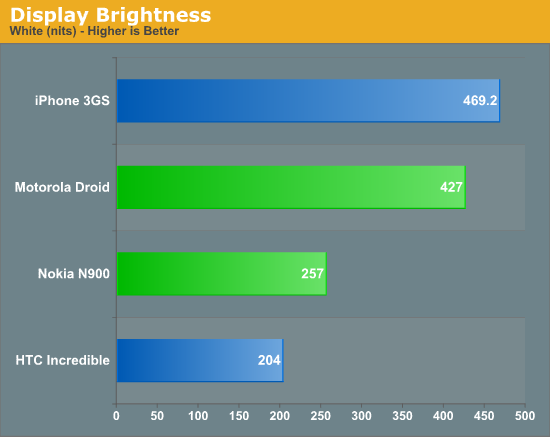

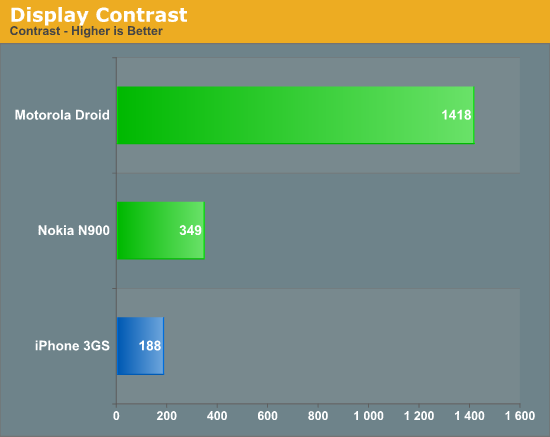
The HTC Droid Incredible is notably absent from the display contrast graph because contrast is... well... infinite in this circumstance. Or at least indeterminate. Whatever the case, AMOLED delivers the absolute best contrast possible. It's really amazing in person.
Outdoors, however, the N900 is an obvious winner - just look at the direct sunlight example down below. The AMOLED display on the Incredible is more difficult to read in indirect sunlight, and very challenging to look at in direct sunlight.
One last thing I'd like to note is that I've read in more than a few articles some claims that the AMOLED display is readable with polarized glasses - that there aren't any angles where there is complete extinction like with normal LCDs. This is false; rotate any AMOLED screen around, and brightness will still fall off following cosine squared like any other analyzing polarizer.


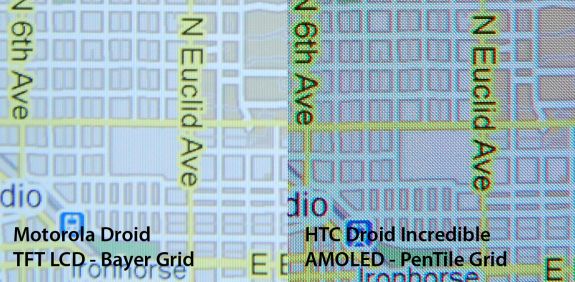
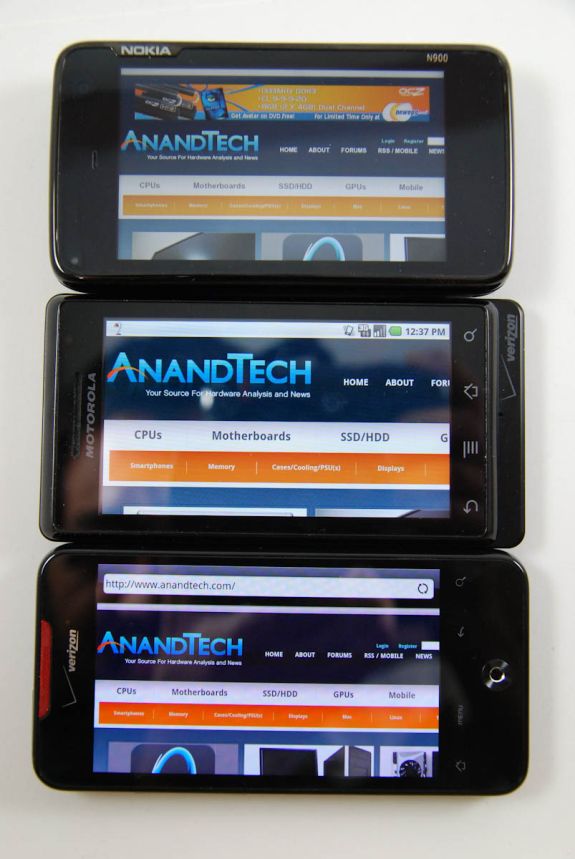
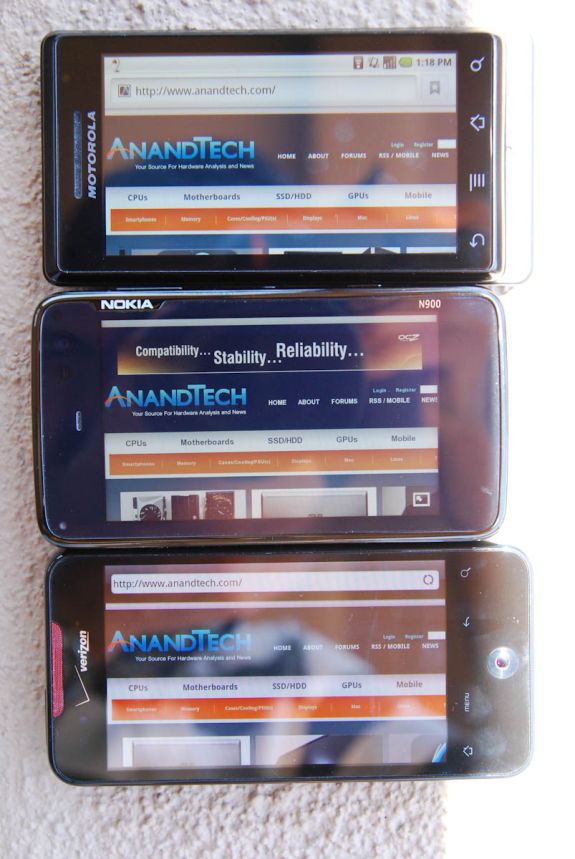
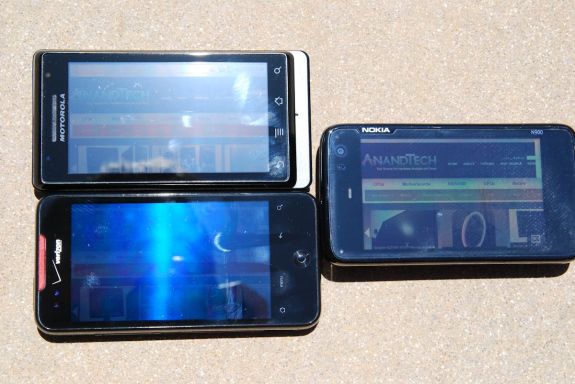








68 Comments
View All Comments
akse - Friday, June 11, 2010 - link
I've got my N900 clocked to use 250Mhz idle and 805Mhz stress clocks and it fastens everything by huge amount. 600Mhz is sometimes a bit slow and if you up it a little bit, everything starts to get smoother..The custom kernel is using lower voltages but higher clocks than nokia stock kernel.. which is why 805mhz drains just about the same amount of power than 600mhz with stock kernel.
I just love the fact that you can do that kind of things on this phone..
One guy was asking how to backup sms messages.. well there wasn't any app for it so you could just run a command with sqlite in Xterm to search through the database for all sms's and forward the results with > to a text file :)
Exodite - Friday, June 11, 2010 - link
That's a truly epic article, the in-depth look at both the hard- and software side of things is far and above what I'm used to reading regarding smartphone reviews. Many thanks for that!Looking forward to similar articles in the future.
medi01 - Friday, June 11, 2010 - link
Epic, right, and you don't care that Apple's device is visible where it has advantage but is not shown, where it doesn't. Like on contrast comparison images.Misterious.
Exodite - Friday, June 11, 2010 - link
No, can't say I mind that at all really.Then again I'm not in the market for an iPhone anyway.
Brian Klug - Friday, June 11, 2010 - link
I actually completely spaced on that one - I probably had a 3GS in my pocket when I took those photos.There's no conspiracy - I just thought that the Incredible's AMOLED display would make an interesting comparison with the Motorola Droid's LCD, and the N900's resistive layer would mix things up a bit.
The iPhone screen really shows its age in the numbers from the bench though. It leaks light pretty badly and obviously the lower PPI is... well... bad.
Cheers,
Brian
Rayb - Friday, June 11, 2010 - link
Nokia has been making devices that work without much hoopla for a long time. It is not for everyone but it beats the available iPhone in more useful ways than is possible.Helmore - Friday, June 11, 2010 - link
The Adrena 200 is based on the AMD Z430 GPU. A Z340 does not even exist AFAIK.I know, I'm nitpicking here, but I just thought I had to mention it.
The Adreno 200 runs at a frequency of 133 MHz, giving it a theoretical performance of 133 MPixels/s of fill rate and 22 Million Triangle/s. The Adreno 205 is the same core but running at 200 MHz and is what will be used in the MSM7X30 and QSD8X50A (45 nm version of the current Snapdragon chip with some small tweaks). The SGX530 used in the Droid (OMAP3430) runs at around 100 MHz, which should give it a theoretical fill rate of 250 MPixels/s and a 7 million Triangles/s. On the OMAP3630 the SGX530 will run at 200 MHz AFAIK. That's all theoretical performance, as we all know they're only part of the story. Just take a look at the GTX480 and the Radeon 5870 and you'll know that theoretical performance doesn't get you very far.
fabarati - Friday, June 11, 2010 - link
1) there was a mistake on the N900 hardware page: it's a 3.5 mm jack, not a 1.8 mm. You probably mixed it up with 1/8"2) The N900 can do Video calling over 3G, like most 3G phones in Europe have done since 2003. It works ok, but it's hella expensive, so no one does it more than once or twice.
Brian Klug - Friday, June 11, 2010 - link
Fixed! Thanks!-Brian
wobblysausage - Tuesday, June 15, 2010 - link
Lies! It cannot make a 3g video call.It can make a skype video call (or a google chat video call) over a 3g data connection but this is not the same thing. Not nearly.
I've had my N900 since November and this is the 1 thing I really miss.